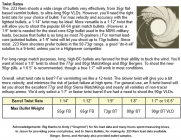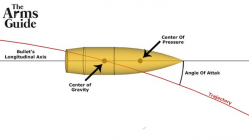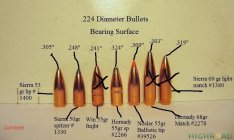I have a Remington 700 with 1/12 twist. I'd like to experiment with heavier bullets. I'm wondering if it's the length or the bearing surface that is affected by twist. For example would a heavier flat base bullet be more stable than a boat tail? When comparing the two in the 52-53 grain weight at 100 yards, my barrel prefers flat based bullets by far. Thanks.
You are using an out of date browser. It may not display this or other websites correctly.
You should upgrade or use an alternative browser.
You should upgrade or use an alternative browser.
.223 bullet length question
- Thread starter Aim-far
- Start date
It is the bullet diameter, length and twist rate…
There are calculators on line that you could experiment with… This one for Berger is an example. You could choose similar bullets to see how stable you would be under different conditions….

 bergerbullets.com
bergerbullets.com
There are calculators on line that you could experiment with… This one for Berger is an example. You could choose similar bullets to see how stable you would be under different conditions….

Twist Rate Stability Calculator
Our newly updated Twist Rate Stability Calculator not only tells you what your SG is, but it also lets you know if you are reaching your optimized BC.
Length is the biggest factor. For example, the 150 gn RN vs 150 gn Spitzer. Both same weight, but you'll need more spin on the spitzerI have a Remington 700 with 1/12 twist. I'd like to experiment with heavier bullets. I'm wondering if it's the length or the bearing surface that is affected by twist. For example would a heavier flat base bullet be more stable than a boat tail? When comparing the two in the 52-53 grain weight at 100 yards, my barrel prefers flat based bullets by far. Thanks.
Coyotefurharvester
Silver $$ Contributor
The work has been done for you, choose bullets with a twist rate recommendation 1/12 or slower. Hint Hornady 62 gr VT will not be on it.
Thanks for your replies. I've been trying to improve my ballistics knowledge. I was surprised to discover the flat based bullets grouped so much better for me and thought the longer bearing surface was a factor. of course this is only at 100 yards, so as I move out it'll be interesting to see how things change. Thanks again.
RegionRat
Gold $$ Contributor
A basic guide to 223 from the main web site. FWIW
https://www.accurateshooter.com/cartridge-guides/223rem/

https://www.accurateshooter.com/cartridge-guides/223rem/

Yes you are correct. A flat base would be more likely to stabilize than a boatail bullet.I have a Remington 700 with 1/12 twist. I'd like to experiment with heavier bullets. I'm wondering if it's the length or the bearing surface that is affected by twist. For example would a heavier flat base bullet be more stable than a boat tail? When comparing the two in the 52-53 grain weight at 100 yards, my barrel prefers flat based bullets by far. Thanks.
I can stabilize the 60gr Vmax, 63gr Sierra smp, and 70gr Speer Semi round nose varmint bullet all in my 12 twist.
On the other hand, the 69 Sierra MatchKing does horrible I'm my 12 twist.
ELR LVR
Silver $$ Contributor
You are stabilizing the "TOTAL LENGTH" of a projectileI have a Remington 700 with 1/12 twist. I'd like to experiment with heavier bullets. I'm wondering if it's the length or the bearing surface that is affected by twist. For example would a heavier flat base bullet be more stable than a boat tail? When comparing the two in the 52-53 grain weight at 100 yards, my barrel prefers flat based bullets by far. Thanks.
Bearing surface is not even taken into the equation.
This is also why the freakin light weight plastic ballistic tips can muck everything up
making the bullet a bit longer
Such as suddenly switching from Sierra SMK's to TMK's
What once was stabilized is no longer stable
Even with the exact same bullet weight.
It has to do with Center of Pressure vs center of gravity
The center of pressure is always ahead of the CG
The more forward the center of force(pressure) is moved the more it tries to push the nose
over the center of gravity (results in tumbling)
A longer tip, has more leverage to push the tip over the center of gravity and cause tumbling
Here is a diagram

------------
If the rifling lands are imparting spin on the bullet, then they are spinning the bullet...
no matter how much bearing surface is being engraved into the bullet by the lands.
------------
The more correct the twist matches the bullet, the better the tip(Meplat) follows the trajectory
Like a perfectly thrown football
Faster twist - keeps the nose more upward inline with the longitudinal axis along its flight trajectory
Meaning, the bullet will stay horizontal even as it falls intead of progressively starting to nose over and point downward as it falls.
With the bullet nose tipped up above its trajectory path like this it causes more drag the further out it travels which usually is only pertinent at long distances of 1000 yds and more.
Since this is when a bullet really begins to "Fall" out of the sky
------------
Slower twist - A Marginally stable bullet - can allow what is called nodding(Nutating) such as when you start nodding off while driving.
The bullet may only nutate slightly through out its entire flight path
Yet once transonic will start to tumble and go way off its flight path.
This also, causes more drag since more frontal surface area is presented to the air
I have found even though not optimal, even a SG (Gyroscopic stability) factor of 1.4 still works fine
You just must adjust and correct your BC, which Bergers calculator does for you.
Given the choice between the 2, I prefer overstablized bullets. (tighter twists)
------------
I like Bergers stability calculator on their website.
Last edited:
CF Junkie
Gold $$ Contributor
I have a 1:9 twist in a 26 inch barrel that shoots 77 grain bullets great as good or better than every other bullet, even though they are not supposed to stabilize with a 1:9 twist. I finally measured the twist of the barrel and it was actually 1:8.75. That and the barrel length might be the reason that the 77gr bullets stabilize.
I spoke to a machinist and he explained that setting the rifling cutting speed on a lathe is difficult to get exactly right and if he was trying to meet a spec for twist, he would set the speed so that he would get a twist that was slightly faster so that the spec would definitely be met.
I would suggest you measure the twist of your barrel. You might find that is slightly faster than 1:12 and you might get away with a bit more weight than is is supposed to stabilize.
I have a 1:14 twist Remington .22-250 that won't shoot 55 gr bullets well, but it loves 52 and 53 gr bullets.
I also have a 1:12 twist Savage .22-250 that loves 55 gn bullets but accuracy falls off around 60 grs.
Every barrel is different and you have to experiment to find what it likes.
I spoke to a machinist and he explained that setting the rifling cutting speed on a lathe is difficult to get exactly right and if he was trying to meet a spec for twist, he would set the speed so that he would get a twist that was slightly faster so that the spec would definitely be met.
I would suggest you measure the twist of your barrel. You might find that is slightly faster than 1:12 and you might get away with a bit more weight than is is supposed to stabilize.
I have a 1:14 twist Remington .22-250 that won't shoot 55 gr bullets well, but it loves 52 and 53 gr bullets.
I also have a 1:12 twist Savage .22-250 that loves 55 gn bullets but accuracy falls off around 60 grs.
Every barrel is different and you have to experiment to find what it likes.
You are stabilizing the "TOTAL LENGTH" of a projectile
Just so. Still not understood by many who'll tell you with 100% certainty that such and such a weight of bullet in so and so a calibre needs at least X inches twist. In reality, bullet OALs vary considerably these days between makes and designs so one model may be fully stabilised and a same weight competitor is marginally so, or even unstable.
Yes you are correct. A flat base would be more likely to stabilize than a boatail bullet.
Also, just so. As a result stability calculators based on the Millers Rules equations give inaccurate results as they are for boat-tail bullets which need a higher rate of spin than FBs.
As an example, take the Berger 6mm 88gn FB whose OAL is nominally 0.925-inches. Put that into any of the common Miller-based calculators including Berger's own and you're told you need a 1 in 9-inch or faster twist barrel.
However, the Berger calculator start page has this notice and link to another part of the site:
Important Note: The Miller Twist Rate Formula isn’t accurate with flat based bullets, so we recommend you view our flat based bullet twist rate chart to identify what the minimum twist rate is for all of our flat based bullets.
That takes you a table which provides the minimum twist rate for each of the company's FB models, and for the 88 FB six, it shows 1 in 10 inches for full stability.
Returning to the OP's query, Berger shows 1 in 12 is needed for its heaviest FB 0.224 model, the 60gn FB Varmint. Many, many years ago there was a Berger 62gn 0.224 FB Match bullet with a pointier front-end and was presumably longer than this Varmint model, and it shot extremely well in 12 twist 223s.
That example and the existence of Sierra's 0.224 semi-pointed FB soft-points in 60-63 (64?) gn weights originally intended for the 1 in 14-inch twist 222 Rem suggests that Berger's table is (understandably) a tad cautious.
For 223 and lighter BT models, Bryan Litz (Ballistic Performance of Rifle Bullets 3rd edition) measures the 0.224 55gn Sierra FMJBT as 0.752-inch OAL. Input those details plus 3,200 fps MV in a 12-twist into a stability calculator and it says the combination is stable, but inadequately so with a coefficient of stability (Sg) value of 1.30 at 59-deg F and sea level atmospheric pressure. 1.4 is what we're looking for, and Berger recommends 1.5 these days. This again seems a tad pessimistic as I'd assume (maybe wrongly I admit) that Sierra's 55gn FMJBT with cannelure is the commercial equivalent of the bullet loaded in the original US military 5.56 M193 round and M16 rifle with its 12-twist barrel.
Steve Donlon
Gold $$ Contributor
I think the 6.5 Lapua 144 bullet is a good example of that compared to the Berger 6.5 144 bullet.You are stabilizing the "TOTAL LENGTH" of a projectile
Bearing surface is not even taken into the equation.
This is also why the freakin light weight plastic ballistic tips can muck everything up
making the bullet a bit longer
Such as suddenly switching from Sierra SMK's to TMK's
What once was stabilized is no longer stable
Even with the exact same bullet weight.
It has to do with Center of Pressure vs center of gravity
The center of pressure is always ahead of the CG
The more forward the center of force(pressure) is moved the more it tries to push the nose
over the center of gravity (results in tumbling)
A longer tip, has more leverage to push the tip over the center of gravity and cause tumbling
Here is a diagram
View attachment 1694348
------------
If the rifling lands are imparting spin on the bullet, then they are spinning the bullet...
no matter how much bearing surface is being engraved into the bullet by the lands.
------------
The more correct the twist matches the bullet, the better the tip(Meplat) follows the trajectory
Like a perfectly thrown football
Faster twist - keeps the nose more upward inline with the longitudinal axis along its flight trajectory
Meaning, the bullet will stay horizontal even as it falls intead of progressively starting to nose over and point downward as it falls.
With the bullet nose tipped up above its trajectory path like this it causes more drag the further out it travels which usually is only pertinent at long distances of 1000 yds and more.
Since this is when a bullet really begins to "Fall" out of the sky
------------
Slower twist - A Marginally stable bullet - can allow what is called nodding(Nutating) such as when you start nodding off while driving.
The bullet may only nutate slightly through out its entire flight path
Yet once transonic will start to tumble and go way off its flight path.
This also, causes more drag since more frontal surface area is presented to the air
I have found even though not optimal, even a SG (Gyroscopic stability) factor of 1.4 still works fine
You just must adjust and correct your BC, which Bergers calculator does for you.
Given the choice between the 2, I prefer overstablized bullets. (tighter twists)
------------
I like Bergers stability calculator on their website.
ELR LVR
Silver $$ Contributor
Good point, I hope and figure that Lapua 144 will perform better than the BergerI think the 6.5 Lapua 144 bullet is a good example of that compared to the Berger 6.5 144 bullet.
The Berger 144 did not do well for me even though the 153.5 did
so I know the 8 twist was fine for it.
will be interesting when i get the chance to pit the Lapua 144 against the Berger version.
I would almost put money on the Lapua before even testing it, they make great bullets
ELR LVR
Silver $$ Contributor
yes, the weight really only has a small amount to do with it, because a same weight bullet can be longerJust so. Still not understood by many who'll tell you with 100% certainty that such and such a weight of bullet in so and so a calibre needs at least X inches twist. In reality, bullet OALs vary considerably these days between makes and designs so one model may be fully stabilised and a same weight competitor is marginally so, or even unstable.
.
such as less boat tail/longer ogive
vs
more boat tail/ more blunt ogive
------------
more weight in a specific caliber "usually means longer" but not always
so even a heavier bullet can be more stable / than a slightly lighter bullet of the same caliber
Last edited:
Steve Donlon
Gold $$ Contributor
From what i have seen at only 1000 yards, they shoot better, faster, higher BC and more constant. Plus they fit my chamber better, easier to get to the lands. Looking forward to what you ELR shooters think.Good point, I hope and figure that Lapua 144 will perform better than the Berger
The Berger 144 did not do well for me even though the 153.5 did
so I know the 8 twist was fine for it.
will be interesting when i get the chance to pit the Lapua 144 against the Berger version.
I would almost put money on the Lapua before even testing it, they make great bullets
Similar threads
- Replies
- 32
- Views
- 3,627
Upgrades & Donations
This Forum's expenses are primarily paid by member contributions. You can upgrade your Forum membership in seconds. Gold and Silver members get unlimited FREE classifieds for one year. Gold members can upload custom avatars.

Click Upgrade Membership Button ABOVE to get Gold or Silver Status.
You can also donate any amount, large or small, with the button below. Include your Forum Name in the PayPal Notes field.
To DONATE by CHECK, or make a recurring donation, CLICK HERE to learn how.

Click Upgrade Membership Button ABOVE to get Gold or Silver Status.
You can also donate any amount, large or small, with the button below. Include your Forum Name in the PayPal Notes field.
To DONATE by CHECK, or make a recurring donation, CLICK HERE to learn how.










